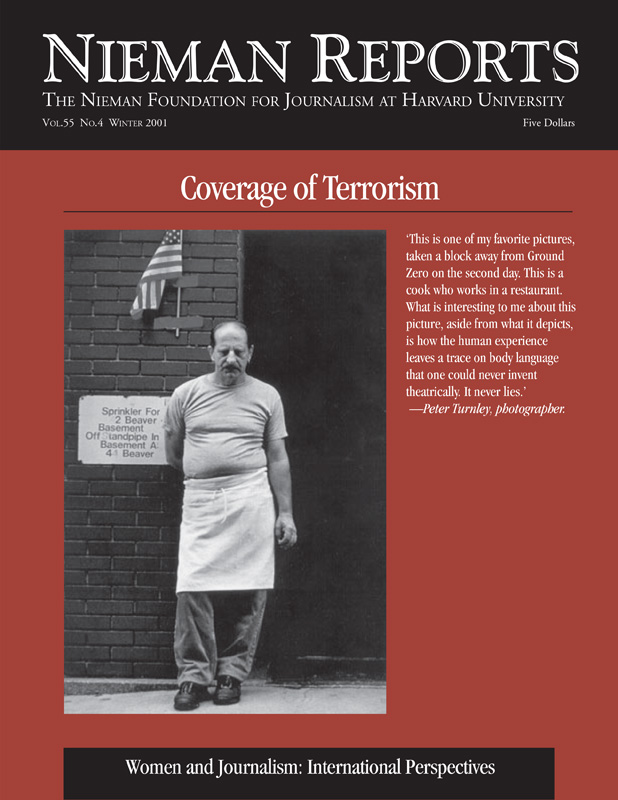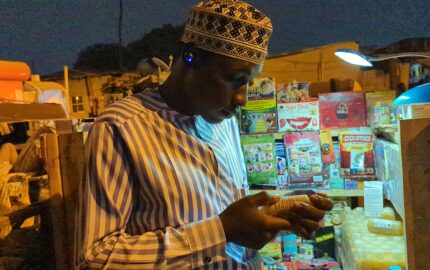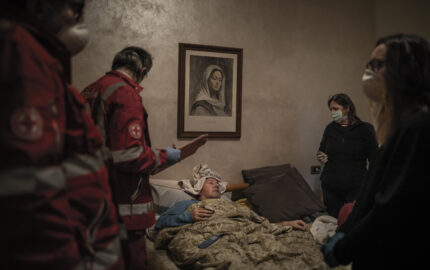
From where I sit, as editor of Worldwoman—an online news service written for and about women—mainstream news could use a lot less blind obedience, hierarchy and conformity and a lot more vigorous challenge. And the voices of those that are often excluded could substitute a lot more action and focus for their resentment and passivity. In short, women need to save the news reading planet from chronic boredom by developing an alternative news agenda fast.
I set up my first feminist magazine at Oxford University in 1978. It was called Lilith after Adam’s mythical first wife who refused to lie beneath him and was banished from Eden for her cheek. Much of the content was desperately worthy—I remember trying to make a story out of the Boilermakers Union donating 40 pounds to the local Women’s Aid hostel. And I remember having to argue strenuously that Lilith would not be avoided by women embarrassed that its name reminded them of—hush it—tampons.
We thought that we were groundbreaking, but we were like primary kids painting with colors for the first time. Opinions were easy to chant about but harder to develop, adapt, refresh, relate and, yes, write about. Even at lofty Oxford University, girls regurgitated facts but tended not to develop personal agendas, never mind worldviews. We acquired knowledge but were not encouraged to develop insight. We got our brains working to analyze massive problems but weren’t expected to persevere and suggest solutions. Clever girls. Boring newspaper. But we were young.
In 1991, feminist magazine number two was born and named Harpies and Quines. At its birth, the magazine was sued by the mighty Harpers and Queen, owned by National Magazines, due to the likeness of our names. Apparently they thought our scurrilous rag could be mistaken for a glossy debs and homes, frocks and gardens kind of magazine. We kept calm, used the press, got Britain-wide publicity, and forced Harpers to climb down. Three years later, the nightmare of distribution costs did what H&Q could not and closed us down.
That was enough fringe activity and enough time worrying only about women and the dinosaurs of print. For the next decade, I was in broadcasting—radio and television—and discovered that a good live broadcaster can set a distinctive news agenda without too much fuss. However, the print challenge remained.
By 1995, I’d become deputy editor of The Scotsman, Scotland’s primary quality daily newspaper. At 182 years of age, the newspaper needed to be modernized and made more attractive to younger people and women. As I looked across newspapers, radio and TV stations I could find plenty of female reporters but hardly any female correspondents, lead writers, political columnists, news editors, program editors, newspaper editors, or owners. Jobs that required comment, judgment and well-cultivated contacts, jobs that shaped public opinion and set agendas, these jobs were filled mostly by men.
I wondered why. And I wondered if it mattered.
It did. Women readers were drifting away from almost all broadsheet papers. The Scotsman, in 1995, was no exception. Was the content unreflectively male oriented? Discussions about this were frustrating. A well-run paper is rarely a deeply reflective one. The men who ran The Scotsman did not—perhaps they could not—challenge their own decision-making on a daily basis. The relentless pressure of paper production required unselfconscious decision-making about who should cover which stories and how those stories should be written. The suggestion that their decision-making habits might be a source of trouble provoked a very frosty, hostile reaction.
I realized there was only one way to demonstrate how a set of values can underpin each word, picture, opinion and promotion. I suggested that one edition of the paper should be written, produced and edited by the women on the paper and published as the Scotswoman on International Women’s Day, 1994. I was amazed when I discovered I didn’t have to argue the case at the next board meeting. Some men reacted so strongly, so immediately, and so angrily against the very idea of change that they converted the more moderate men into my instant allies.
Creating Scotswoman
This left us 10 weeks to achieve a world first—the first Scotswoman paper. Some women argued the idea was patronizing, that there wasn’t one “women’s view” of any issue and that the whole project was a token waste of time. I let the staff argue out these important questions and come to a majority decision. Thankfully, the decision was to proceed.
A month before this paper would be published, 30 female journalists sat in a room for two hours and discussed news coverage. At first, it was hard. When no one has asked your opinion on the big stories, it’s tempting to revert to passive silence or criticism. But soon the opinions were flowing. What is foreign news? Pictures of men in uniforms with guns, and men in suits with power. Much war and conflict reporting is about how people die and fight, cheat and wrangle, but has little to do with how people live in different cultures. No one suggested we ignore coverage of war, but we also wanted to make more space for stories about topics like paternity leave in Norway. Apparently lots of men there use their state-funded leave to go fishing. The female politicians who introduced the leave were apparently checking up on the men’s whereabouts. Everyone agreed that was the sort of story they wanted to see in foreign news.
Additionally, we wanted women being actors in the news we published, and not simply seen as passive objects. But the truth was then, and is now, that women just don’t make the “news” as news is conventionally defined. Women’s opinions don’t usually shake stock markets. Nor do their actions normally provoke wars or strikes or disputes. Their casual purchases don’t destroy or create thousands of jobs. Their work doesn’t usually attract Nobel Prizes or vast research awards, and their hopes rarely shape new political parties or movements.
We wanted to produce a real newspaper, not a fantasy one, so we had to find ways to make women’s views newsworthy. I employed a prominent transportation expert to look at a new proposed motorway round Glasgow. Professor Carmen Hass-Klau analyzed the evidence and concluded that the council was indirectly discriminating against women by spending millions on new motorways, not on new public transport. Her views made news, even by existing standards. Then, we found the most inaccessible train platform in Scotland and challenged the male boss of the Scottish Trade Union Movement to cross it with one baby stroller, two children and four bags of shopping. The resulting pictures later persuaded Railtrack to install lifts.
We had a men’s page, too, with a self-examination graphic for testicular cancer. Strangely, this was one male disease that the male-led news team had never thought to cover. There was also a fashion spread on how men can match their shoes with their briefcases. We decided to make a statement about the cynical use of naked women in fashion shoots by using an undressed male model—with the briefcase covering his modesty! This went down surprisingly well—with both sexes. Humor was important among all the “earnest” stuff that the male staff feared and readers might have expected.
The presses went into action and vans and trains shot off around Britain to deliver this very special edition. The Scotswoman sold out in about three hours. There was publicity about it in 22 countries and letters and faxes came pouring in for weeks afterwards. The vast majority were supportive; a few were appalled.
By the next morning, it was business as usual at The Scotsman with no real analysis about what was learned and what was achieved. By the next year, our project was downgraded to a tabloid supplement; the following year, it was scrapped. When I left the paper, it seemed the idea had died. But in 1998 the British Council in Scotland invited me to talk to a bunch of women politicians and activists from 41 developing countries about women and the media. I showed them the Scotswoman papers, and their response was emotional and intense. They also longed to produce something different and not just talk about it.
Worldwoman and the African Experience
A while later, I figured that the Internet would have to be part of the answer. That’s when I set up Worldwoman as a women’s Web paper to be a source of women’s stories, available to interested editors in many countries. I devoted the best part of two years looking for funding. Too worthy to be commercial, yet not safe enough to get U.N.-type funding, we were fortunate to get some financial backing from Scottish Enterprise and a lot of voluntary help with the Web site from Jim Byrne at Glasgow Caledonian University.
Meanwhile, in 1999, the secretary general of UNESCO decided to encourage women in newsrooms to have a “Takeover Day” on International Women’s Day. With their backing, 600 news outlets did this; more joined in 2000. However, what I wanted to do was develop an alternative news agenda and not just a series of one-shot publications.
With British Council backing, I visited four of the African countries that were interested in developing a worldwide women’s news agenda. I realized during my visit that their need for personal development and my desire to create a stable of sassy women writers throughout the world were walking hand in hand. And at least one of those hands was also holding onto the women activists in Africa who were confronting the massive burden of AIDS, as well as working to end the cycle of corruption, war and exploitation in their continent. These African women I met with wanted to develop a voice. Their voice. To do that requires patience, practice, work, support and fun.
The idea of encouraging and training a pilot group of women journalists by producing a paper like Worldwoman on the Internet started to form before I went to the SWAA (Society for Women and AIDS in Africa) conference of HIV-positive women in Uganda this past March. Four hundred women from all over Africa were present, representing probably the largest group of HIV-positive women on the planet. But there was more media coverage of Kofi Annan’s one-day visit to Kenya.
These women delegates knew nothing of impending AIDS-related conferences of the G7 in Genoa or U.N. in New York. Their views were not being canvassed by international journalists. Delegates knew little about the details of the anti-retroviral court case in South Africa and what it might mean for imports of generic drugs in their own countries. The women were well-organized, articulate and passionate but disconnected from the mainstream news and decision-making agenda. These brave and focused women were outside of the food chain called news.
A quick solution was for me to write a few stories about them and their concerns. And I did. But these activists need skilled African journalists to tell their stories. The role for well-meaning outsiders like me is to provide support, mentors, encouragement and cash. And that’s what the virtual newsroom (VNR) pilot project at Worldwoman is all about.
The VNR is an Internet tool to connect women journalists in four African countries (Ghana, Zimbabwe, Uganda and Kenya). They’ve been trained together face-to-face to understand more about news values and journalism, and they are using an intranet to set their own collective agenda, swap stories of best practice, news and information, and create a new net paper. At the moment, their netpaper is private, primarily to protect Zimbabwean writers, in particular, and basically to allow the journalists a bit more freedom at the start. When they are satisfied that they are ready to “go live,” Africawoman will be launched. It will be a Web paper written by African women journalists to be read by African women and the news will also be delivered via community radio to be heard by millions of women across Africa.
RELATED ARTICLE
"Community Radio Provides Women a Way to Have Their Voices Heard"
- L. Muthoni WanyekiWorldwoman has linked up with Development Through Radio (DTR)—a Zimbabwe-based charity—to use the Internet to send the netpaper to their growing network of women-led community radio stations. Together, our goal is to have every country in Africa broadcasting a women’s news service by 2003. Worldwoman will use the Internet, recording studios, and rural radio listening groups to send news bulletins and news features across Africa and pick up local stories to feed back to the journalists. In 2003, we hope to expand facilities to help African women producing plays, soaps and documentaries to make programs for the network of DTR women’s stations.
Within three years, Worldwoman would like to transfer control of editorial, finances and production of this ambitious media project to the African women whom we are currently training. The DTR Project—popularly known as the Radio Listeners’ Clubs—was launched in 1988 by Jennifer Sibanda to give rural women access to national radio. Through training, the project develops leadership qualities, encourages women to share experiences, and links rural people with policymakers. Now there are women’s community-run radio stations and women-run programs on existing national broadcasting stations in Angola, Botswana, Lesotho, Malawi, Mozambique, Namibia, Swaziland, Tanzania, Zambia and Zimbabwe. DTR is expanding its work to Nigeria, Ghana and Sierra Leones. DTR has a massive listenership, but needs news material. Africawoman has news material, but needs a virtual audience, and women activists in Africa need a voice. It’s time they all worked together.
Worldwoman envisions a different way to use the Internet in rural Africa. We don’t think there will be a vast network of marginalized African women reading Africawoman on computers. Internet links are too expensive and computers too rare for most Africans. But the net is already being used as a virtual whiteboard by our remote news teams when they create their Web paper together. It can be used as a virtual post box when we send copy to local radio stations. And the computer can serve as a portable printing press so information need only be downloaded and printed out once to then be communicated to tens of thousands of women listening to community radio. Using the net and the “written word” this way, rural women who might wait a generation to become literate can hear what they need to know next year, and hear it from sisters across Africa.
This media project is not a one-way street. Direct communication between the rural women and journalists will happen on a monthly basis. But we hope e-mail will become a regular “direct” channel, too. There is a phone line to the women’s community radio stations in Malawi and Mozambique. So a computer and modem and printer could supply Africawoman news and allow activists to join the virtual-newsroom intranet. Once trained—in the cascade training event we are fundraising to realize in March 2002—a key activist in each group will be trained to be sufficiently skilled to keep in touch and to start additional local training.
We also think that editions of Africawoman can be published to coincide with important meetings or summits that affect grassroots women. One special edition is already being planned for the Rio plus 10 summit in 2002. Few grassroots activists ever get to attend decision-makers’ conferences; Africawoman will bring the mountain to Mohammed. Not only do we plan to send Africawoman to DTR’s entire radio network, but we’re also working on the idea of a weekly news service that would become daily when those stations have more demand for that amount of news. We are also planning Commonwoman—a Commonwealth version of Africawoman to be inserted into existing newspapers as a supplement on March 12, 2002 (Commonwealth Day). This would expand the whole project to Asia while keeping editorial control in Africa, and there would then be a repetition of the virtual training we’ve begun in Africa.
Worldwoman’s aim is to train groups of women journalists throughout the world to work together to create their own virtual or actual publications, to encourage women’s community radio networks, and to have top quality journalists writing for a weekly Worldwoman that will be essential reading to half the world’s population, and pretty damn interesting for men, too. In countries around the world, women are confronting similar challenges and fighting similar battles, and even though they are separated by continents, oceans, languages, customs and religions, by mixing technology with cleverness, enthusiasm and skill building, connections through news can and should be made.
Lesley Riddoch is editor of Worldwoman.


